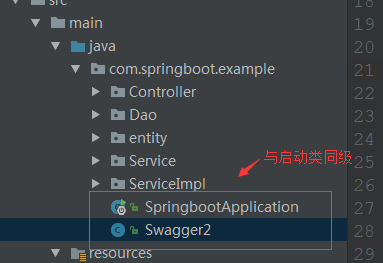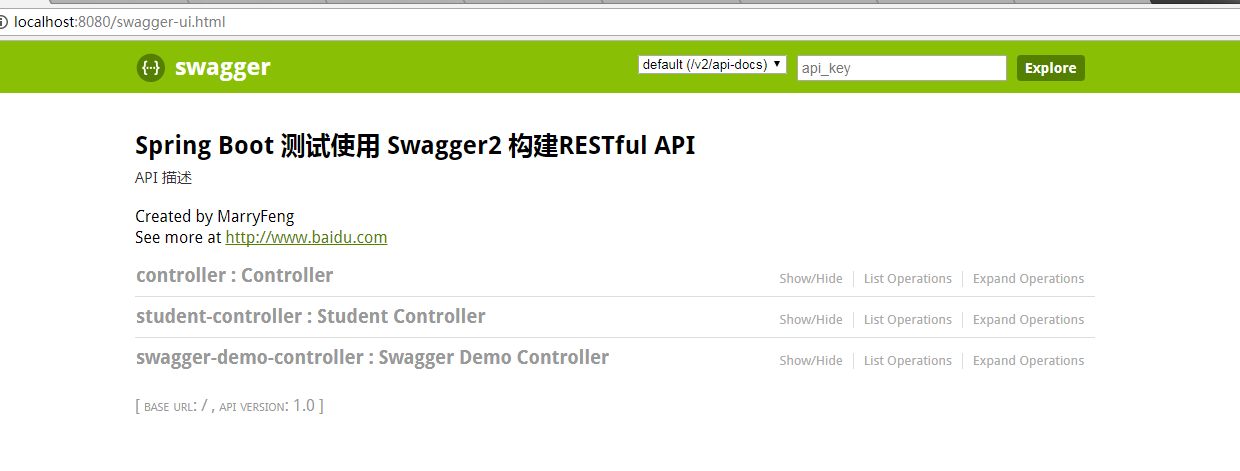微服务学习二:springboot与swagger2的集成
现在测试都提倡自动化测试,那我们作为后台的开发人员,也得进步下啊,以前用postman来测试后台接口,那个麻烦啊,一个字母输错就导致测试失败,现在swagger的出现可谓是拯救了这些开发人员,便捷之处真的不是一点两点。下面我们看下如何在微服务中将springboot与swagger来结合吧。
1、swagger是什么,这个我觉得凡是一个开发人员就应该知道度娘啊,绝对强大。
简单说下,它的出现就是为了方便进行测试后台的restful形式的接口,实现动态的更新,当我们在后台的接口修改了后,swagger可以实现自动的更新,而不需要认为的维护这个接口进行测试。
2、springboot与swagger的集成:
第一步:jar包的引入:

关于jar包的引入出现了一个问题就是版本的问题,可能需要与你的编辑器或者jdk要匹配吧,试了几个才最终成功导入jar。
第二步:swagger的配置启动类编写:
要使用swagger要进行一些配置,这个在界面的图上是可以显示的:类似于说明书:在这个类中我们会使用注解来进行启动swagger:

具体配置如下:
package com.springboot.example;
//swagger2的配置文件,在项目的启动类的同级文件建立
import org.springframework.context.annotation.Bean;
import org.springframework.context.annotation.Configuration;
import springfox.documentation.builders.ApiInfoBuilder;
import springfox.documentation.builders.PathSelectors;
import springfox.documentation.builders.RequestHandlerSelectors;
import springfox.documentation.service.ApiInfo;
import springfox.documentation.service.Contact;
import springfox.documentation.spi.DocumentationType;
import springfox.documentation.spring.web.plugins.Docket;
import springfox.documentation.swagger2.annotations.EnableSwagger2;
@Configuration
@EnableSwagger2
public class Swagger2 {
//swagger2的配置文件,这里可以配置swagger2的一些基本的内容,比如扫描的包等等
@Bean
public Docket createRestApi() {
return new Docket(DocumentationType.SWAGGER_2)
.apiInfo(apiInfo())
.select()
//为当前包路径
.apis(RequestHandlerSelectors.basePackage("com.springboot.example.Controller"))
.paths(PathSelectors.any())
.build();
}
//构建 api文档的详细信息函数,注意这里的注解引用的是哪个
private ApiInfo apiInfo() {
return new ApiInfoBuilder()
//页面标题
.title("Spring Boot 测试使用 Swagger2 构建RESTful API")
//创建人
.contact(new Contact("MarryFeng", "http://www.baidu.com", ""))
//版本号
.version("1.0")
//描述
.description("API 描述")
.build();
}
}
这里的坑是:所使用类的引入文件要注意到底是哪个,之前因为这个出错了,
@Configuration @EnableSwagger2
这两个注解,一个是swagger2的配置,一个是项目启动的时候启动swagger2.
具体什么意思看下代码就知道了。
//为当前包路径 .apis(RequestHandlerSelectors.basePackage("com.springboot.example.Controller"))
这个包指的是我们在哪些类中使用swagger2来测试。
第三步:使用swagger来进行模拟测试:
使用swagger2来进行测试接口主要是在哪些类中使用:这里我们依然选择在controller层:
package com.springboot.example.Controller;
import com.springboot.example.Service.StudentService;
import com.springboot.example.entity.Student;
import io.swagger.annotations.Api;
import io.swagger.annotations.ApiImplicitParam;
import io.swagger.annotations.ApiOperation;
import org.slf4j.Logger;
import org.slf4j.LoggerFactory;
import org.springframework.beans.factory.annotation.Autowired;
import org.springframework.web.bind.annotation.PathVariable;
import org.springframework.web.bind.annotation.RequestMapping;
import org.springframework.web.bind.annotation.RequestMethod;
import org.springframework.web.bind.annotation.RestController;
/**
* Created by Administrator on 2017/9/13.
*/
@RestController
@RequestMapping("api")
@Api("swaggerDemoController相关的api")
public class SwaggerDemoController {
@Autowired
private StudentService studentService;
private static final Logger logger= LoggerFactory.getLogger(SwaggerDemoController.class);
@ApiOperation(value = "根据id查询学生信息", notes = "查询数据库中某个的学生信息")
@ApiImplicitParam(name = "id", value = "学生ID", paramType = "path", required = true, dataType = "Integer")
@RequestMapping(value = "/{id}", method = RequestMethod.GET)
public Student getStudent(@PathVariable int id) {
logger.info("开始查询某个学生信息");
return studentService.selectStudentById(id);
}
}

上面这些可以看下具体的注解是什么意思:
这样swagger2与springboot就集成完毕了。
看下最终效果吧:
访问路径:
http://localhost:8080/swagger-ui.html


输入id后,我们可以看到查询结果:、

是不是很方便,我们不用像postman一样来编写入口,swagger2自动完成:
而且实时更新:

是不是很方便!
至此swagger2与springboot的集成完毕。



 浙公网安备 33010602011771号
浙公网安备 33010602011771号